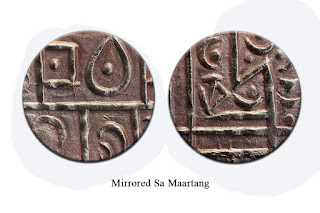Recently a coin collector and Tibetologist from Germany - David Holler - noticed a spelling mistake in our 1981 Nu.10 banknote and wrote as follows:
Bhutan: Spelling mistake on banknote
In the Tibetan script of the 10 Ngultrum banknote from 1981 (P8) there is a misspelling in the promise to pay.
David Holler is referring to our following second-generation Nu.10 banknote issued by the Royal Government of Bhutan but signed by the then Deputy Managing Director Mr. Yeshey Dorji of the Bank of Bhutan.
Thankfully, in the third generation of the Nu.10 banknote, signed by the then Chairman of the Royal Monetary Authority of Bhutan – HRH Ashi S C Wangchuck, His Majesty’s Representative in the Ministry of Finance, the Promise to Pay was correctly worded as follows:
But what Mr. Holler seems to have missed out is the uncommon manner in which the Promissory Note is worded, as follows:
A word for word English translation of the above Promissory Note would read as follows:
Promise is hereby made to pay the bearer a sum of the face value of Ngultrum 10
It would appear that Mr. Hollar omitted to pointed out the mistake contained in the country's first Nu.10 banknote, as follows:
The banknote bears the signature of HRH Ashi S C Wangchuck, His Majesty's Representative in the Ministry of Finance but the organization on whose behalf she signs is designated the Department of Finance, as follows:
The organization should have rightfully been named the Ministry of Finance, as follows:
The above errors are minor design flaws – what is truly shameful is the manner in which we have spelt the word: NGULTRUM. It should have been correctly spelt as: NGUELTANG:
Nguel = Silver
Tang = Coin
That being said, calling our paper currency “Ngultrum” or even “Ngueltang” would be totally incorrect - because our banknotes are neither silver, nor coin. Regardless, if I were to choose between the two words, I would opt for the word “Ngueltang” since it has the backing of the legitimacy of history behind it - the history behind the emergence of one of the three earliest of our monies - our metal currency. It is too lengthy to deal with the subject here - I will do so in my book, when it is eventually released.
Another discrepancy: History records that the term “Ngultrum/Ngueltang” was coined when we issued our paper currency for the first time in 1974. But the country’s earliest Postage Stamp issued in 1962 is proof that the term was in existence more than a decade earlier, if not more. The following is the history of the morphology of the term:
To be fair, perhaps it is in our genes to commit errors – and allow it to perpetuate for centuries thereafter. Look at one of the following earliest of our metal currencies. Of the nine alphabets hammered on it, most likely sometime during the late 1700s, eight of them are foreign alphabets. Only one: SA is our own.
In a number of cases, the coins’ dies were wrongly engraved – resulting in the following coin’s alphabet “SA” being rendered in a mirrored state:
A large number of coins were over-struck, as follows:
Even our earliest milled silver coins were not without problems. Look at the following Silver Thala of 1929/1930. The word “Druk” is wrongly rendered while the date of minting was depicted wrongly – as “Sa Druk Lo” while the actual striking took place during “Sa Drue Lo”.
An erroneous issue of our 1950 Tikchang is considered one of Bhutan’s rarest coins – for the reason that it was struck with the wrong date of “Sa Druk Lo”. The Calcutta GoI Mint where the coins were minted, had mistakenly used the wrong die - the correct die should have been the one with the year of minting marked “Chaag Taag Lo”. The mistake was detected and the minting of the coin was hastily halted.
Of all the calamitous errors, the following coin of 1966 is the most deplorable - you can see the reason why:
The above is the coin for the reason for which my coin book will stop at 1955.













No comments:
Post a Comment